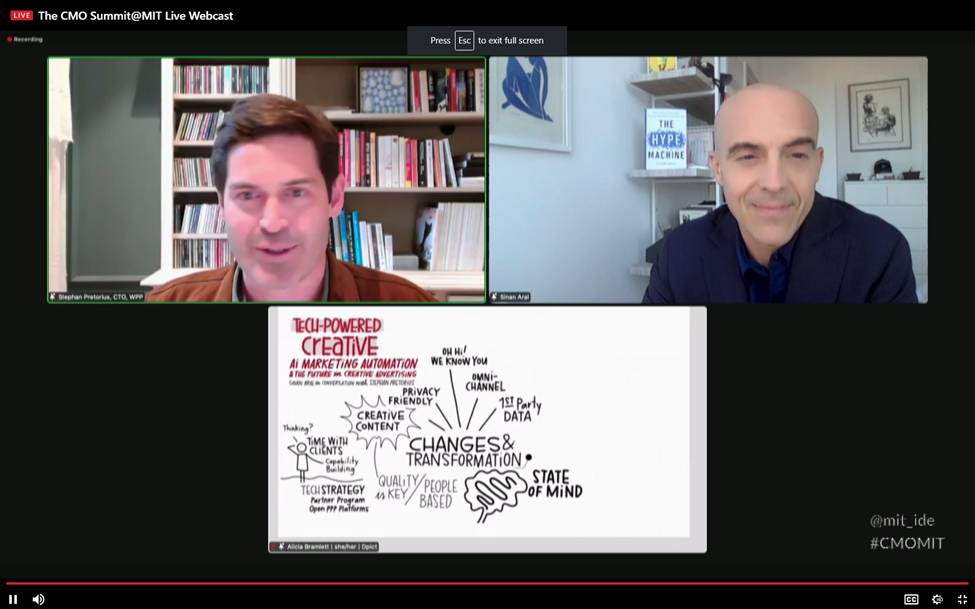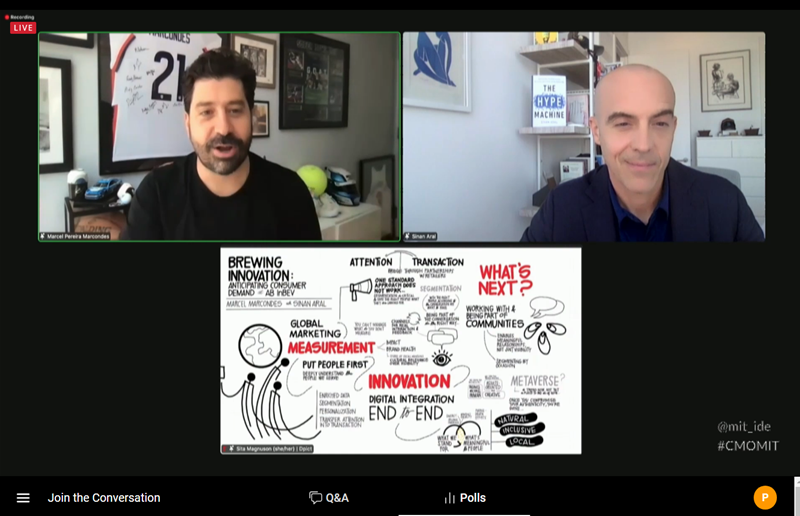
Tech helps global brands — from beer to newspapers — attract and retain customers in a fast-paced, omnichannel world
By Paula Klein
From the latest TikTok video to the pages of the 150-year-old Boston Globe, marketing technology is embedded in our economy. Algorithms predict and monitor the products, brands, and services we consume, how inventory is replenished and priced, and what the next big trends will be.
But navigating the fast-paced world of digital marketing is more complex than it may appear. Under the hood of today’s social media, TV, and print ad campaigns, data engineers are crunching numbers and experimenting with machine learning (ML) and AI to sharpen marketing investments, according to researchers and industry executives speaking at the first MIT CMO Summit on April 28. At the same time, they need to protect privacy and achieve meaningful customer engagement, not just clicks — an often elusive goal.
Understanding ‘Networked Consumers’
MIT IDE Director, Sinan Aral, told attendees that researchers are working collaboratively with marketing executives to understand “the networked consumer” and to use technology to effectively meet their needs.
“We’ve essentially gone through four decades of consumer engagement strategies,” he said. The eras of personalization and audience segmentation are over, and new models are emerging. “Since about 2010, we have been in the era of the socially linked consumer who gets information and makes brand decisions based on a very broad set of digitally connected networks, whether on Facebook or WhatsApp.” Given the fast-pace of marketing tech,
If your brand is still focused on segmentation, you’re about three decades behind. Consumers are affected by so much more than targeted ads. — Sinan Aral
That’s the value of field studies and digital experimentation. Aral’s research shows how managers and platform advertisers can invest more in social ads that work well based on large-scale testing. The tests will tell them, for instance, “whether you want to bid more for social ads on Facebook.” It’s not a one-size fits all decision, he said.
MIT Assistant Professor, Dean Eckles, who leads the Social Networks & Digital Experimentation Research Group at the IDE, is also trying to address customer targeting by using ML to forecast outcomes more quickly and accurately. His recent study aimed at determining long-term customer revenue in collaboration with the Boston Globe. Waiting months or years to measure the results of promotional incentives, like discounts, can waste precious time and dollars, he said.
The IDE and the Boston Globe also built “a model to understand the dynamic news consumption interests of readers over five years. Thorough qualitative studies, including a crowdsourced evaluation, researchers identified nuanced and coherent consumption patterns accurately,” said Paramveer Dhillon, Assistant Professor, University of Michigan and a recent postdoctoral associate at the MIT Sloan School of Management. In effect, neural networks analyzed clickstream data to find out what content users really read, not what they say they read.
WPP Builds Relationships
Even the largest global firms are looking for new approaches to long-standing issues: better consumer retention, less churn, and higher revenue. Stephan Pretorius, Chief Technology Officer at WPP, oversees tech communications, public relations technology, and advertising at the largest advertising company in the world. “No one who works in marketing or advertising today can survive, without having extremely strong, intimate relationships with [firms] from Google to Meta, to Amazon, to TikTok,” he said.

Stephan Pretorius, WPP CTO (top left) at the CMO Summit with MIT’s Sinan Aral.
His priority? “We’re trying to crack the combination of highly dynamic and intelligent content with a very real time, very accurate understanding of consumers… and bring the two together.” And all of that can be completely privately, he said. “We do not need to know who the person is, or have any personal information about them to execute accordingly.”
In fact, Pretorius agreed with Aral that using third-party cookies as a way to track consumers is an awful idea.
It was done for conversion tracking back in the day… and there was no ill intent, but surveillance is not a good consumer experience.” And unfortunately, he added, “it’s become surveillance — no one likes that, it’s creepy.”
Pretorius agreed that the rapid transformation in marketing, “even in the last two to three years” has been a result of technology automation, machine learning, and more sophisticated omnichannel conversations.”
Brewing New Ideas at AB InBev
The key to today’s marketing is “all about communities and deeply understanding the customers we serve,” said Marcel Marcondes, Global CMO, AB InBev, and former CMO, Anheuser-Busch — the world’s largest brewer. He too, is trying to digitize consumer interactions as much as possible “so that we can transform data into insights in a much more effective way.” For instance: How does the company reach more female customers, expand its non-beer offerings and become a part of people’s life ‘occasions’ — not just sporting events?

InBev’s Marcel Marcondes (top left) speaking with Sinan Aral of the IDE.
Part of the plan at AB InBev is to approach social media differently than in the past by tracking the share of social mentions it gets, “because it’s all about how much people are talking about what we do, how much are we part of the conversation, instead of how much of the media pie we are buying.”
We want to make sure that we are culturally relevant, not just visible.–Marcel Marcondes
Digital marketing also helps these giant firms become more agile, innovative, and effective, because “we can have online conversations with a big base of consumers, and we can interact with them in a much faster way to check concepts, to prototype, and also to get input once something is already out in the market,” Marcondes said.
Other topics discussed at the event included:
- Scalable Bundling: Combining Machine Learning and Field Experiments, by Madhav Kumar, PhD Candidate, MIT Sloan School of Management
- AI & Cognitive Bias, presented by Renée Richardson Gosline, Human/AI Interface, Research Group Lead, MIT IDE
- How Brands Are Using Creative Data to Drive Performance, presented by Andrea Ward, CMO, VidMob
2022 Marketing Tech Trends
What’s In:
Social consumers in broad networks of media
Video marketing, especially TikTok and YouTube
Direct customer engagement
Adding “good friction” to reduce AI bias
What’s Out:
Third-party cookies and surveillance
Emojis as customer interest indicators
Long-term analysis
Assuming AI is neutral — it’s not
